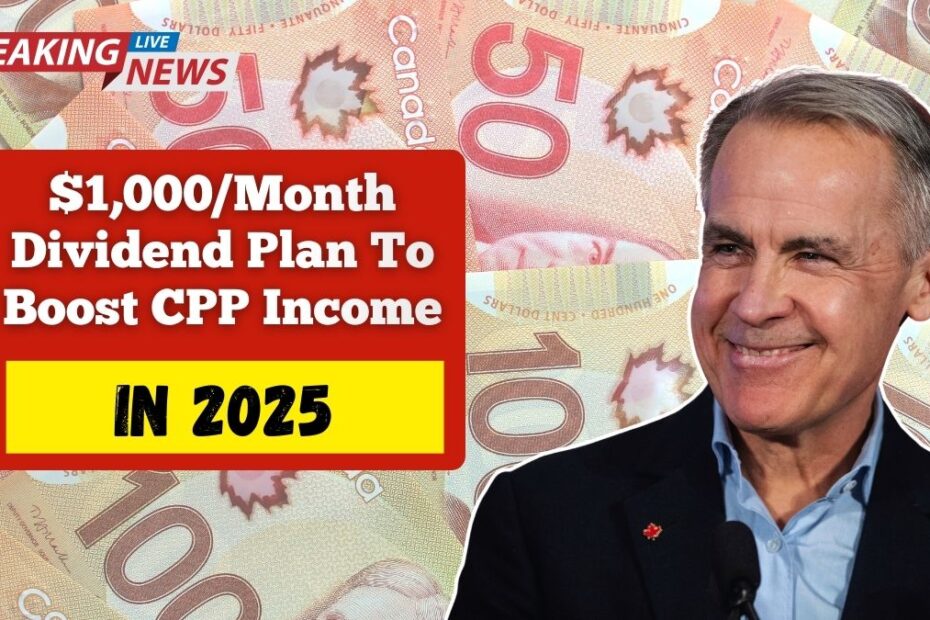$1,000/Month Dividend Plan: Many Canadians dream of a peaceful and stress-free retirement, but depending only on the Canada Pension Plan (CPP) may not be enough to cover daily expenses.
The average CPP payment in 2025 is around $760 per month, and even the highest possible payout—just over $1,300 per month—still leaves a lot of people searching for extra income.
This is why more Canadians are now building a simple and reliable $1,000 per month dividend plan to support their CPP. This strategy is easy to start, beginner-friendly, and helps retirees enjoy more financial stability and freedom.
What Is a Dividend Income Plan?
A dividend income plan is a method of investing where you choose strong and trusted companies or ETFs that pay regular cash dividends. These payments often come monthly or every three months. The goal is to build a portfolio that earns steady and predictable cash flow for life.
How Dividend Plans Work
Dividend plans work best when you invest in:
- Canadian banks
- Telecom companies
- Utility providers
- Safe REITs (Real Estate Investment Trusts)
These industries usually give reliable dividend payouts, making them perfect for long-term retirement income.
How to Build a $1,000/Month Dividend Income
To receive $1,000 every month, or $12,000 every year, you must understand how portfolio yield affects how much you need to invest.
Required Investment Based on Yield
Here is a simple table to help you understand the investment amount needed at different average dividend yields:
| Annual Dividend Goal | Average Portfolio Yield | Required Capital |
|---|---|---|
| $12,000 | 4.0% | $300,000 |
| $12,000 | 5.0% | $240,000 |
| $12,000 | 6.0% | $200,000 |
A 5% yield is the most common for safe, high-quality dividend stocks. That means you would need around $240,000 saved.
Many Canadians slowly build this amount during their working years with accounts like:
- Tax-Free Savings Account (TFSA)
- Registered Retirement Savings Plan (RRSP)
Both accounts help your money grow faster while reducing taxes.
Best Dividend Stocks and ETFs for Canadian Retirees
A strong portfolio should include companies known for stability and consistent dividend payments. Some examples include:
Top Canadian Dividend Stocks
- Royal Bank of Canada (RBC)
- Toronto-Dominion Bank (TD)
- Bank of Montreal (BMO)
- BCE
- Telus
- Fortis
- Emera
- Canadian Utilities
Why ETFs Are Also Great
Many retirees prefer Dividend ETFs because they:
- Reduce risk
- Include many stocks in one fund
- Provide steady income
- Are easy to manage
Using a mix of stocks and ETFs helps protect your income even if one company faces financial issues.
How Dividends Are Taxed in Retirement
Taxes play a big role in retirement planning. The good news is that Canada makes dividend income tax-efficient.
Tax Benefits
- Eligible dividends receive a special dividend tax credit when held in non-registered accounts.
- TFSA dividends are always tax-free, making this account ideal for building retirement income.
- Smart planning helps avoid OAS clawbacks and reduces overall taxes.
Keeping the Plan Simple and Safe
A successful dividend plan should always focus on:
- Stable companies, not risky high-yield stocks
- Consistent dividend growth
- Balanced diversification
- Reinvesting dividends during working years
When you retire, you can stop reinvesting and start using the dividends as monthly income.
Creating a $1,000 per month dividend plan gives Canadians a dependable way to increase their retirement income beyond what CPP offers.
With careful planning, smart investments, and steady contributions over time, even small steps today can turn into strong financial security tomorrow. This strategy offers retirees more comfort, freedom, and confidence to enjoy life without constantly worrying about money.
FAQs
How much money do I need to earn $1,000/month in dividends?
You will need around $240,000 if your portfolio gives an average 5% annual yield.
Are dividend payments taxed differently?
Yes. Canadian eligible dividends receive tax credits, and TFSA dividends are fully tax-free.
What if I cannot save $240,000 before retirement?
Start with whatever amount you can. Even a smaller dividend income helps support your CPP, and you can grow the plan over time.
